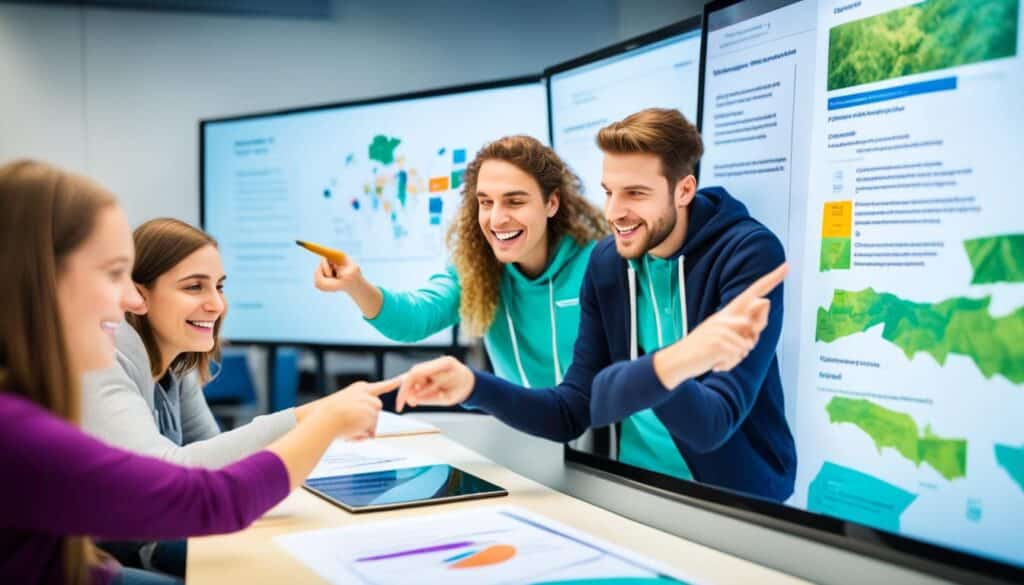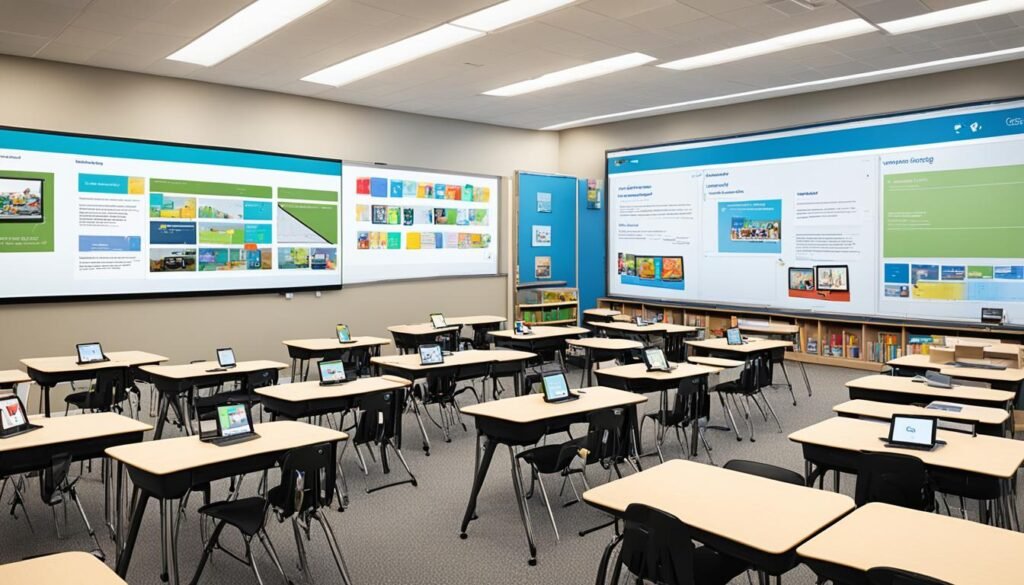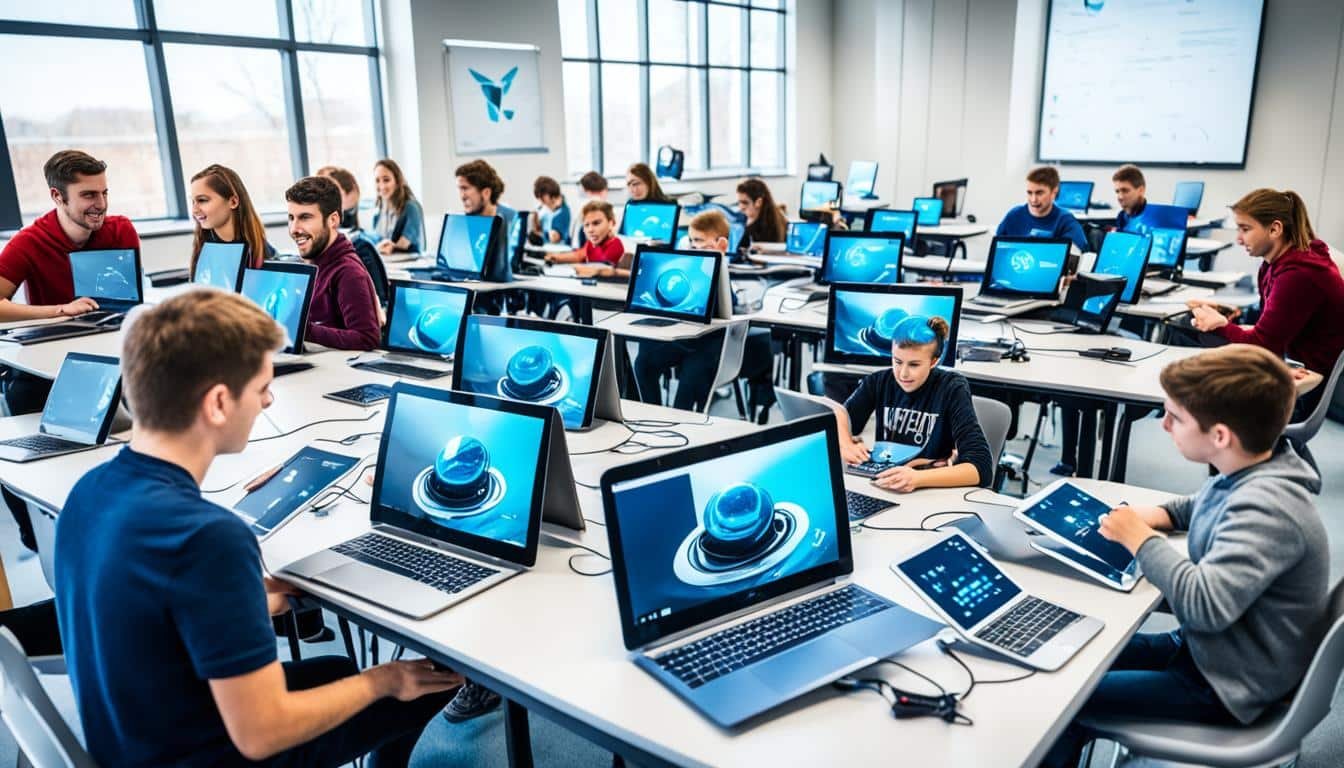Technology has revolutionized K-12 education, transforming the learning experience for students and educators. With the integration of educational technology, classrooms have become dynamic and inclusive, enhancing accessibility and personalized instruction.
Through innovative tools and resources, such as interactive digital resources and online learning platforms, technology has provided students with increased access to information and opportunities for collaboration. This has resulted in a more engaging and effective learning environment.
Key Takeaways : Impact of Technology on Education
- Technology has revolutionized K-12 education
- Integration of technology enhances accessibility and personalized instruction
- Interactive digital resources and online learning platforms provide increased access to information
- Technology promotes collaboration and creates a more engaging learning environment
- Technology in education is a significant trend shaping the future of learning
Equity and Access in Education Technology
Technology has played a crucial role in bridging the digital divide and providing equitable access to educational resources. The effects of technology in the education sector have been profound, breaking down geographical barriers and enabling students of all socioeconomic backgrounds to access educational materials and tools.
Despite these advancements, challenges remain in ensuring equal access to technology, particularly in underserved communities. The digital divide still persists, with disparities in access to technology and internet connectivity. This divide can further exacerbate existing educational inequalities, hindering students’ ability to fully participate in the digital age.
Efforts are being made to address these issues and narrow the gap. Governments, educational institutions, and non-profit organizations are working towards providing devices, internet access, and digital literacy training to underserved communities. The goal is to ensure that every student has the opportunity to benefit from technology in teaching and learning.
One of the key strategies is to integrate technology effectively in classrooms, ensuring that it is not just a tool but a means to enhance the learning experience. Teachers are being trained on how to incorporate technology in their lessons, tailoring it to meet the individual needs of students. This integration goes beyond using technology for the sake of it; it focuses on leveraging technology to create engaging and impactful learning experiences.
In addition to equal access, it is important to consider the effects of technology on teaching and learning. As educators embrace technology, they must also address any negative consequences or distractions it may pose. By fostering a balanced approach, technology can be harnessed to support students’ development of critical thinking, problem-solving, and digital literacy skills.
“Technology is not a panacea for all educational challenges, but when used strategically and equitably, it can empower students and broaden their educational horizons.” – Jane Smith, Educational Researcher
The education sector is at a pivotal moment, with technology playing a central role in transforming teaching and learning. Through continued efforts to bridge the digital divide and enhance access to technology, we can create a more inclusive and equitable education system for all.
| Challenges | Solutions |
|---|---|
| Disparities in access to technology and internet connectivity | Providing devices, internet access, and digital literacy training to underserved communities |
| Integrating technology effectively in classrooms | Training teachers on how to incorporate technology in a way that enhances the learning experience |
| Addressing negative consequences and distractions of technology | Fostering a balanced approach to technology use and supporting students’ development of essential skills |
Personalized Learning and Technology
Technology in education has ushered in a new era of personalized learning experiences. By harnessing the power of technology, educators can cater to individual student needs and create a more inclusive learning environment.
Adaptive learning platforms and educational software have revolutionized the way students learn. These tools take into account each student’s unique learning style and pace, allowing them to progress at their own speed. With personalized learning, students have the freedom to explore topics that interest them and focus on areas where they need more support.
This tailored approach to education empowers students to take ownership of their learning and encourages them to become active participants in the classroom. Through the integration of technology, students can access a wide range of resources and learning materials that are specifically curated to meet their individual needs.
Technology has transformed education into a dynamic and personalized experience, where each student can thrive and reach their full potential.
With the integration of technology, students are no longer limited by traditional teaching methods or a one-size-fits-all curriculum. They are equipped with the tools and resources to pursue their passions and explore topics of interest at their own pace.
Furthermore, technology facilitates collaboration and interaction among students, fostering a sense of community and teamwork. Online platforms and collaborative tools enable students to work together on projects, exchange ideas, and learn from one another.
Benefits of Personalized Learning and Technology
- Enhanced engagement: Personalized learning experiences through technology captivate students’ attention and make learning more enjoyable.
- Individualized instruction: Technology allows educators to tailor their teaching methods to address the unique needs and learning styles of each student.
- Flexible learning pathways: Students have the freedom to explore different paths and areas of interest without being confined to a predetermined curriculum.
- Greater access to resources: Technology provides students with access to a vast array of educational resources, including digital libraries, interactive tools, and multimedia content.
The integration of technology and personalized learning experiences is transforming education and preparing students for the challenges of the 21st century. It equips them with essential digital literacy skills and nurtures their ability to adapt to a rapidly changing world.
| Benefits of Personalized Learning and Technology | Impact on Students |
|---|---|
| Enhanced engagement | Students are more motivated and enthusiastic about learning when it is personalized to their interests and needs. |
| Individualized instruction | Students receive tailored support and guidance from their educators to help them achieve their full potential. |
| Flexible learning pathways | Students have the freedom to explore their own interests and pursue learning in a way that suits their unique needs. |
| Greater access to resources | Technology provides students with a wealth of educational resources that were previously inaccessible, expanding their knowledge and understanding. |
Technology has opened up new possibilities for personalized learning, empowering students to take control of their education and equipping them with the skills they need to succeed in an ever-evolving world.
Enhanced Engagement and Collaboration
Incorporating technology in the classroom has revolutionized student engagement and collaboration. Utilizing interactive whiteboards, tablets, and other devices, teachers can introduce multimedia elements into their lessons, enhancing the learning experience for students. Multimedia content, such as videos and interactive presentations, captivates students’ attention and promotes active participation.
Technology in the classroom allows for creative and engaging activities that foster deeper understanding and critical thinking. It provides a platform for students to explore diverse perspectives, express their ideas, and collaborate with their peers.
Collaborative learning platforms further facilitate teamwork and communication skills. These platforms enable students to collaborate on projects, share ideas, and develop problem-solving abilities collectively. By working together, students gain valuable experience in collaboration and learn to appreciate the benefits of collective intelligence.
The collaborative nature of using technology in the classroom extends beyond physical boundaries. Through virtual classrooms and online discussion forums, students from different locations can come together to learn and exchange ideas. This global collaboration nurtures cultural awareness and prepares students for the collaborative nature of the modern workforce.
To visualize the impact of technology on enhancing engagement and collaboration in the classroom, the table below highlights key benefits:
| Enhanced Engagement and Collaboration in the Classroom | Benefits |
|---|---|
| Integration of multimedia elements | • Stimulates students’ interest and attention • Supports different learning styles • Promotes active participation |
| Collaborative learning platforms | • Fosters teamwork and communication skills • Encourages sharing of ideas and perspectives • Develops problem-solving abilities |
| Virtual classrooms and online discussion forums | • Facilitates global collaboration • Nurtures cultural awareness • Prepares students for the modern workforce |

Overall, technology has redefined student engagement and collaboration in the classroom. By leveraging interactive multimedia, collaborative learning platforms, and virtual communication tools, educators can create an environment that promotes active participation, teamwork, and the development of essential collaboration skills.
Impact on Teaching and Learning
Educational technology has revolutionized the way teachers deliver lessons and engage students in the learning process. With the integration of technology in education, teachers now have powerful tools and resources at their disposal to create dynamic and effective learning environments.
“Technology provides educators with innovative ways to deliver content, making lessons more interactive and engaging for students.”
Gone are the days of relying solely on textbooks. Educational materials are now easily accessible through interactive e-books and online resources. This transformation has not only provided students with up-to-date information at their fingertips but has also opened doors to a world of knowledge beyond the traditional classroom.
Furthermore, technology has played a significant role in developing essential 21st-century skills. Students are equipped with the digital literacy and critical thinking skills necessary to thrive in the digital age.
Enhanced Teaching Methods
Teachers can leverage technology to deliver dynamic and interactive lessons, catering to the diverse learning needs of their students. Whether through multimedia presentations, educational apps, or online platforms, technology has transformed the way teachers engage with their students.
“The integration of technology in education has transformed teaching from a one-size-fits-all approach to a personalized and adaptable experience.”

Empowering Students with Technology Skills
By incorporating technology into the curriculum, students develop valuable technology skills that are essential for success in the modern world. They learn how to navigate digital tools, collaborate online, and think critically when consuming and creating digital content.
Furthermore, the integration of technology in education not only prepares students for the demands of the future workforce but also fosters creativity, problem-solving, and effective communication skills.
Inclusive and Accessible Learning
The integration of technology in education has also paved the way for more inclusive and accessible learning environments. Students with disabilities or special needs can benefit from assistive technologies that cater to their individual learning requirements.
Moreover, technology has the potential to bridge gaps in educational opportunities by providing equal access to resources for all students, regardless of their geographical location or socioeconomic background.
Real-World Connections
Technology has transformed education by connecting students with real-world experiences and experts outside the classroom. Virtual field trips, video conferences with professionals, and online forums allow students to explore different perspectives and gain practical insights.
Through these connections, students can see the relevance of their learning to the world around them, motivating them to engage in their education and pursue further exploration.
Preparing Students for the Future
As technology continues to advance at a rapid pace, it is imperative that students develop the necessary skills to adapt to the changing landscape. The integration of technology in education equips students with the tools they need to thrive in the digital era.
By embracing technology in the classroom, educators are preparing their students for a future where technology will play an increasingly vital role in all aspects of life and work.
Access to Information and Digital Resources
The digital age has revolutionized access to information and transformed the learning landscape. With the internet serving as a vast repository of knowledge, students and educators now have unprecedented access to a wealth of resources. Online platforms, educational websites, and digital libraries have expanded the scope of learning, going beyond traditional textbooks.
From articles and research papers to interactive multimedia content, digital tools have made information more accessible and engaging. Students can explore diverse perspectives and delve deeper into subjects that interest them, broadening their understanding of the world around them. This access to information enhances critical thinking and fosters a thirst for knowledge.
“The internet enables students to access resources and discover information that was once limited to the confines of a classroom or a physical library. It opens up a world of possibilities for learning and discovery.” – Dr. Hannah Alvarez, Professor of Education
Technology has not only expanded access to information but also made education more inclusive and available to all. Digital tools and resources have leveled the playing field by removing geographical and socioeconomic barriers. Students from underserved communities now have the same opportunities to learn and succeed as their peers.
The integration of technology in education has transformed access to education itself, making it more flexible and adaptable to individual needs. Online learning platforms and digital resources provide personalized learning experiences, catering to the unique strengths and challenges of each student. Whether it’s through interactive lessons, virtual simulations, or collaborative projects, technology has enhanced the engagement and motivation of learners.

Benefits of Digital Resources in Education
There are numerous advantages to the integration of digital resources in education:
- Expanded Learning Opportunities: Students have access to a vast range of resources beyond the limitations of traditional textbooks. They can explore diverse subjects, engage with multimedia content, and access up-to-date information.
- Personalized Learning: Digital resources enable personalized learning experiences tailored to individual student needs. Adaptive learning platforms and intelligent algorithms provide targeted feedback and guidance, allowing students to progress at their own pace.
- Collaboration and Communication: Digital tools facilitate collaboration among students, fostering teamwork and communication skills. Online platforms and discussion forums provide opportunities to collaborate on projects, exchange ideas, and engage in peer learning.
- Engagement and Motivation: Interactive digital resources capture students’ attention and make learning more engaging and enjoyable. Gamification elements, virtual simulations, and multimedia content provide interactive experiences that inspire curiosity and foster a love for learning.
Ensuring Equitable Access
While technology has greatly improved access to information and digital resources, there are still challenges to be addressed. The digital divide persists, with some students lacking the necessary devices and internet connection to fully participate in digital learning. Efforts must be made to bridge this gap and ensure that no student is left behind.
Furthermore, educators play a vital role in guiding students in effectively using digital resources and navigating the vast amount of information available online. Teaching digital literacy skills, critical thinking, and information evaluation is essential to equip students with the tools they need to navigate the digital age.
| Benefits | Challenges | |
|---|---|---|
| Access to Information | Expanded learning opportunities, up-to-date information | Digital divide, information overload |
| Digital Tools | Personalized learning, engagement and motivation | Digital literacy, integration challenges |
| Equitable Access to Education | Inclusive learning, leveled playing field | Digital divide, accessibility barriers |
As technology continues to evolve, access to information and digital resources will play an increasingly crucial role in education. By harnessing the power of technology, we can provide every student with the tools and opportunities to thrive in the digital age.
Efficient Administration and Learning Management
Technology has revolutionized administrative tasks within educational institutions, streamlining processes and enhancing efficiency. Digital platforms have provided educators with tools for enrollment, grading, and communication, freeing up valuable time to focus on teaching and addressing students’ individual needs.
Learning management systems (LMS) have played a crucial role in efficient administration by providing centralized platforms for managing resources, assignments, and student engagement. With an LMS, educators can easily create and share learning materials, track student progress, and facilitate online discussions.
One of the key benefits of LMS platforms is the availability of resources for students. Through the LMS, students can access course materials, submit assignments, and participate in collaborative activities. This ensures that students have easy and organized access to all the resources they need, improving their learning experience.
Furthermore, LMS platforms enable educators to provide real-time feedback and assessments, enhancing the teaching and learning process. These systems allow for timely communication of grades and constructive feedback, promoting student engagement and growth.
“The integration of technology in administration and learning management has significantly increased efficiency and effectiveness in education, benefitting both educators and students.”
In addition to improving administrative tasks, technology has also facilitated communication between educators, students, and parents. Through online communication tools, such as email and messaging platforms, stakeholders can easily connect and stay updated on relevant information, fostering a collaborative learning environment.
Overall, technology has provided efficient administration and robust learning management systems, making educational institutions more productive and effective. By leveraging technology, institutions can streamline tasks, improve access to resources, and enhance communication, ultimately advancing the quality of education.

Benefits of Efficient Administration and Learning Management
| Benefits | Description |
|---|---|
| Time-saving | Automation of administrative tasks saves educators valuable time. |
| Centralized resources | LMS platforms provide easy access to learning materials for students. |
| Real-time feedback | Immediate feedback and assessments enhance the teaching and learning process. |
| Improved communication | Technology enables seamless communication between educators, students, and parents. |
Innovative Assessment Methods
Technology has revolutionized the way students’ understanding and progress are evaluated through innovative assessment methods. These methods go beyond traditional paper-based tests and provide a more dynamic and varied approach to assessing student learning. Let’s explore some of these exciting assessment methods and how they enhance the educational experience.
Digital Quizzes

Digital quizzes are interactive assessments that can be easily created and administered through online platforms. These quizzes offer various question formats, such as multiple choice, fill in the blanks, and matching, allowing teachers to test students’ knowledge and comprehension in an engaging way. With automatic grading features, digital quizzes save valuable time for educators and provide instant feedback to students, enabling them to identify areas where they need improvement.
Online Assignments
Online assignments provide students with opportunities to demonstrate their understanding and apply their knowledge through multimedia presentations, research projects, and collaborative tasks. With the integration of technology, students can submit their assignments digitally, simplifying the submission process and allowing for efficient assessment and feedback. Teachers can provide detailed feedback directly on the digital assignments, promoting individualized guidance and fostering a deeper understanding of the subject matter.
Real-time Feedback Mechanisms
Real-time feedback mechanisms, such as online discussion boards and instant messaging, facilitate continuous interaction between teachers and students. These platforms enable students to seek immediate clarifications, ask questions, and receive timely feedback on their work. Real-time feedback promotes active learning, encourages critical thinking, and nurtures a supportive learning community. Through these mechanisms, educators can effectively address students’ misconceptions, reinforce learning objectives, and provide constructive guidance.
By embracing innovative assessment methods like digital quizzes, online assignments, and real-time feedback mechanisms, educators can create a more engaging and student-centered learning environment. These methods not only evaluate students’ performance but also foster critical thinking, problem-solving skills, and digital literacy. As educational technology continues to evolve, it is essential for educators to explore and capitalize on these innovative assessment methods to unlock the full potential of every learner.
Future of Technology in Education
As technology continues to evolve, its role in education is set to transform the learning experience. The future of education will be shaped by technology, with the potential for personalized, immersive, and efficient learning.
Advancements such as artificial intelligence, augmented reality, and blockchain technology are already making their mark in the educational landscape. Artificial intelligence can provide personalized learning experiences by adapting to individual student needs and offering targeted support. Augmented reality can create interactive and engaging learning environments, bringing abstract concepts to life. Blockchain technology can revolutionize credentialing and certification processes, ensuring the authenticity of educational achievements.
Integration of technology in education will continue to revolutionize teaching and learning methods. It opens up new opportunities for collaboration, connecting students from different locations and backgrounds. Digital education platforms and virtual classrooms can provide a global learning community, fostering cross-cultural understanding and collaboration.
Furthermore, technology has the potential to address individual student needs more effectively, providing tailored learning experiences that optimize engagement and achievement. Through adaptive learning algorithms and personalized learning platforms, students can receive targeted instruction and support, allowing them to progress at their own pace and reach their full potential.
Technology is transforming education, and its impact will only grow stronger in the future.
| Advancements | Potential Impact on Education |
|---|---|
| Artificial Intelligence | Personalized learning experiences, targeted support for individual student needs |
| Augmented Reality | Interactive and engaging learning environments, bringing abstract concepts to life |
| Blockchain Technology | Secure credentialing and certification processes, ensuring the authenticity of educational achievements |
Table: Advancements and Their Potential Impact on Education
Challenges and Considerations
While the integration of technology in education brings numerous benefits, it is important to acknowledge and address the challenges and considerations that arise. It is crucial to strike a balance between the positive and negative effects of technology to create a successful and impactful learning environment.
1. Negative Effects of Technology
One significant challenge is mitigating the negative effects that technology can have on students. Distractions from social media, games, and other online platforms can hamper focus and academic performance. It is essential to promote responsible technology use and provide guidance on managing screen time effectively. Additionally, addressing the potential for misuse and ensuring digital safety and privacy are important considerations.
2. Effective Integration
The successful integration of technology requires careful planning and implementation. Educators need to identify appropriate technology tools and platforms that align with educational goals and enhance learning outcomes. It is crucial to consider the specific needs of students and educators to ensure that technology effectively supports teaching and learning processes.
“When integrating technology, it is essential to focus on the learning objectives and how technology can enhance the learning experience.” – John Smith, Education Technologist
3. Professional Development
Supporting educators through professional development is crucial for effective technology integration. Providing training and resources to enhance educators’ technological skills is key to ensuring their confidence and competence in utilizing technology for instructional purposes. Ongoing support and collaboration can help educators navigate challenges and explore innovative ways to leverage technology in the classroom.
4. Equity and Accessibility
Ensuring equitable access to technology can be a significant challenge. Underserved communities may face barriers to technology access, exacerbating existing educational inequalities. Efforts should be made to bridge the digital divide by providing resources and infrastructure to underserved areas. Creating inclusive learning environments that accommodate diverse needs and abilities is also essential.
5. Assessment and Evaluation
The integration of technology necessitates the development of new assessment methods that align with digital learning environments. Educators should explore innovative ways to evaluate student understanding and progress, such as utilizing digital quizzes, online assignments, and real-time feedback mechanisms. These methods offer opportunities for more immediate and targeted feedback, aiding adaptive instruction.
6. Ethical and Legal Considerations
Implementing technology in education requires careful attention to ethical and legal considerations. Privacy and data security should be prioritized to protect students’ personal information. It is essential to adhere to copyright laws and ensure responsible use of digital resources. Educators must also promote digital citizenship and educate students about responsible online behavior and digital ethics.
7. Financial Resources
Investing in technology infrastructure, devices, and software requires financial resources. Educational institutions need to allocate funds to provide equitable access to technology and support ongoing maintenance and upgrades. Sustainable funding models should be considered to ensure long-term availability and viability of technology integration initiatives.
8. Parent and Community Engagement
Engaging parents and the broader community in technology integration efforts is crucial for success. Educators should communicate the benefits of technology in education, address concerns, and actively involve parents in their child’s digital learning experiences. Partnerships with community organizations can provide additional support and resources to enhance technology integration.
| Challenges | Considerations |
|---|---|
| Negative effects of technology | Mitigating distractions and potential misuse, promoting responsible technology use |
| Effective integration | Aligning technology with educational goals, addressing specific needs of students and educators |
| Professional development | Providing training and resources for educators to enhance technological skills |
| Equity and accessibility | Bridging the digital divide, creating inclusive learning environments |
| Assessment and evaluation | Exploring innovative assessment methods that align with digital learning environments |
| Ethical and legal considerations | Ensuring privacy, adhering to copyright laws, promoting digital citizenship |
| Financial resources | Allocating funds for technology infrastructure, devices, and software |
| Parent and community engagement | Communicating benefits, involving parents, partnering with community organizations |
Also Read : Empower Learning with Technology for Online Education
Conclusion
The impact of technology on education has been profound, revolutionizing the learning experience for students and educators alike. Technology has enhanced access to information, personalized learning experiences, and collaborative opportunities. It has transformed teaching methodologies and administrative tasks, increasing efficiency and effectiveness in education. As we look to the future, technology will continue to play a significant role in shaping the education landscape, providing innovative solutions and opportunities for growth and development.
FAQs
Q: What is educational technology and how is it used in the classroom?
A: Educational technology refers to the use of technology to enhance teaching and learning in the classroom. It can include tools like computers, tablets, software, and online resources that help students engage with the curriculum in innovative ways.
Q: What is the digital divide and how does it affect the integration of technology in education?
A: The digital divide refers to the gap between those who have access to technology and those who do not. This divide can impact the integration of technology in education as students without access may be left behind in terms of digital skills and learning opportunities.
Q: What are the positive effects of technology on education?
A: Technology in education has many positive impacts, such as enabling online education, helping students explore and understand complex concepts, and making the learning process more engaging and interactive.
Q: How has technology become an integral part of teaching and learning today?
A: Technology has become an integral part of teaching and learning today by offering tools that streamline the education process, provide access to online courses, and facilitate communication and collaboration among students and teachers.
Q: What is the impact of educational technology in K-12 classrooms?
A: Educational technology has made a significant impact in K-12 classrooms by transforming traditional teaching methods, enhancing student engagement, and preparing students for the digital world they will encounter in the future.
Q: What are the positive and negative effects of technology on education?
A: While technology has brought about positive advancements in education such as personalized learning and increased access to information, it has also raised concerns about screen time, digital distractions, and the potential for decreased face-to-face interaction among students.
Q: How has technology impacted the education process in terms of digital transformation?
A: Technology has led to a profound impact on the education process through digital transformation, allowing for the implementation of new teaching methods, personalized learning experiences, and improved communication between educators and students.
